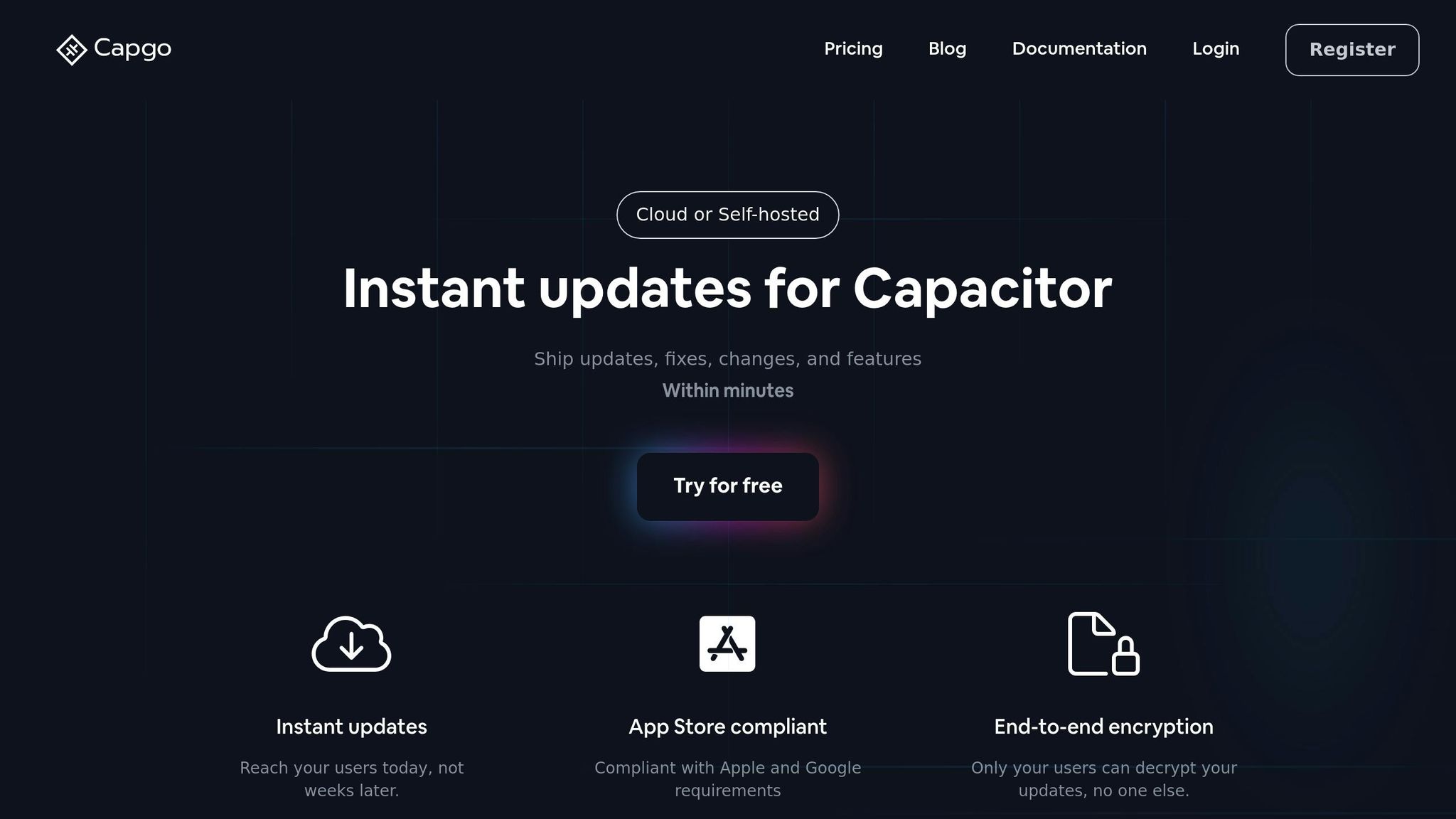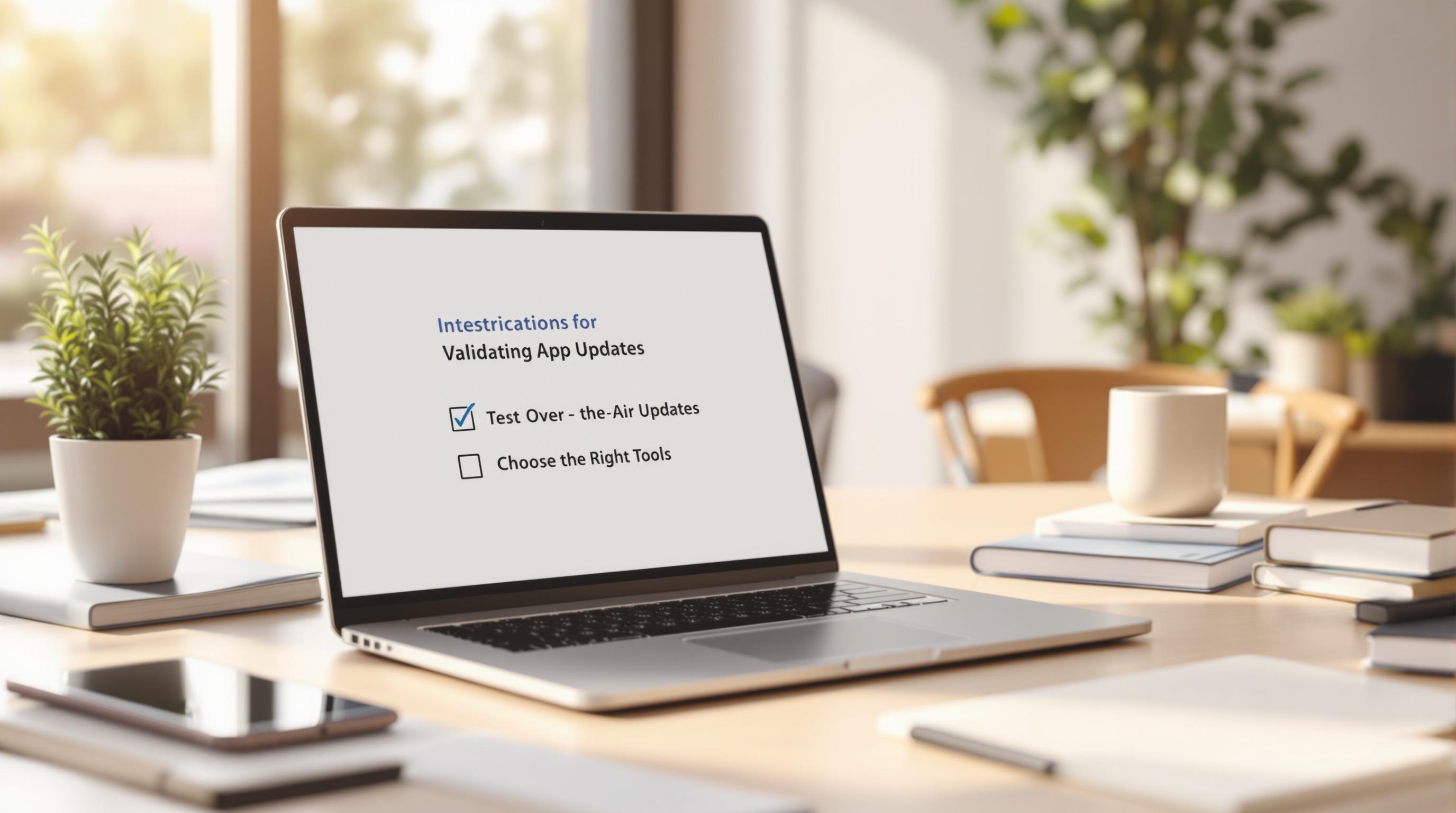Want to deliver smooth app updates without risking user trust? Here’s a quick, actionable checklist for validating Capacitor app updates, especially when using over-the-air (OTA) updates:
- Test Features: Ensure all workflows (like login, data sync) function end-to-end.
- Device Coverage: Test on various devices, operating systems, and screen sizes.
- Performance Checks: Measure speed, responsiveness, and memory usage under different conditions.
- Security: Encrypt OTA updates, assign permissions, and test rollback features.
- Distribution: Use tools like Capgo to ensure 95% of users get updates within 24 hours.
- Post-Release Monitoring: Track success rates (aim for 82%), API response times, and user engagement.
Quick Comparison of OTA Tools
| Feature | Capgo | Appflow | | --- | --- | --- | --- | | Launch Year | 2022 | 2024 | Shutting down 2026 | | End-to-End Encryption | Yes | No | No | | Update Success Rate | 82% | Not published | Not published | | Distribution Speed | 95% within 24h | Varies | Varies | | Self-Hosted Option | Yes | No | No | | Pricing | $300/month | Matches Capgo | $6,000/year |
Follow this checklist and choose the right tools to ensure every update is fast, secure, and reliable.
Ionic & Capacitor for Building Native Mobile Apps – Full …
Pre-Validation Setup
After migration, set up dedicated environments for each platform to ensure smooth and consistent validation.
Testing Environment Setup
Prepare separate testing environments for iOS, Android, and web platforms, following Capacitor’s official guidelines [1]. Secure your codebase by implementing strict version control practices.
Version Control Setup
Set up your repository with the following practices:
- Use feature branches to isolate new updates.
- Integrate with CI/CD systems like GitHub Actions or GitLab CI for automated builds.
- Leverage Capgo’s one-click rollback feature for quick reversion when needed [1].
Capgo Setup

Configure Capgo with these steps [1]:
- Initialize Capgo using:
npx @capgo/cli init. - Set up a channel system to target specific updates.
- Enable end-to-end encryption for added security.
- Turn on error tracking and analytics.
- Configure rollback options for better control.
- Choose between cloud or self-hosted deployment, based on your needs.
For enterprise use, Capgo offers compatibility with Capacitor 6 and 7, and supports both cloud and self-hosted deployments [1]. Once this setup is complete, move on to feature and device testing.
Main Testing Checklist
Once your environments and Capgo setup are ready, focus on these key validations:
Feature Testing
- Ensure primary user workflows (like login, data sync, and navigation) function end-to-end.
- Confirm that new features meet their defined acceptance criteria.
- Use Capgo analytics to track errors and aim for at least an 82% success rate [1].
Device Testing
- Test on both the minimum and latest operating systems for iOS and Android.
- Check functionality on various screen sizes.
- Evaluate performance on both low-end and high-end devices.
- Verify how the app behaves offline and ensure data is retained properly.
Speed and Reliability Testing
- Measure how quickly the app launches and how responsive features are.
- Test performance under different network conditions.
- Check the behavior of background processes.
- Monitor memory usage and battery impact.
Security Testing
- Ensure OTA payloads are encrypted and can only be decrypted by authorized builds.
- Assign specific update permissions to testers and beta users.
- Verify compliance with Apple and Google platform security requirements.
- Test the one-click rollback feature and ensure the rollback process works smoothly.
OTA & Distribution Testing
- Use Capgo channels to roll out updates in stages or to beta groups.
- Confirm that at least 95% of active users receive updates within 24 hours [1].
- Segment users by channel and ensure each segment gets the correct version.
- Track real-time metrics to monitor update success and user engagement.
Final Steps
After completing the main testing phase, focus on validation, documentation, staged rollouts, and ongoing monitoring.
Recording Test Results
Once the primary tests are done, document the results using your analytics platform. Leverage the dashboard you set up during the Pre-Validation phase to track key metrics through Capgo’s analytics tools.
Make sure to log any errors and their resolutions to streamline future updates.
Beta Testing Process
Introduce updates gradually using beta channels [1]:
- Initial Beta Group: Start with a small group of internal testers.
- Expanded Testing: Broaden the beta to include larger groups.
- Monitoring Phase: Keep an eye on metrics and gather user feedback.
- Issue Resolution: Address any problems before the full release.
Ensure beta builds are tested on critical devices to avoid compatibility issues during the official launch.
“Analytics and error tracking” are important for updates. – Capgo [1]
Post-Release Monitoring
Keep track of these critical metrics after deployment:
- Success Rate: Aim for at least 82% (via Capgo Analytics).
- Distribution: Ensure 95% coverage within 24 hours (using Real-time Tracking).
- API Response Time: Maintain responses at or below 434 ms (via Performance Monitor).
Set up alerts to notify your team if any metrics fall below these thresholds.
Next, explore a comparison of OTA tools in the following section.
OTA Update Tools Comparison
Here’s a comparison of top OTA platforms based on security, performance, pricing, and integration. The tool you choose will directly impact your validation process and the reliability of your updates.
The table below provides a quick overview to help you identify the best platform for your needs:
| Feature | Capgo | Appflow | | --- | --- | --- | --- | | Launch Year | 2022 | 2024 | Shutting down 2026 | | End-to-End Encryption | Yes[1] | No | No | | Update Success Rate | 82%[1] | Not published | Not published | | Distribution Speed | 95% within 24 h[1] | Varies by provider | Varies by provider | | API Response Time | 434 ms[1] | Not published | Not published | | Self-Hosted Option | Yes[1] | No | No |
[1] Capgo platform statistics.
Pricing
- Capgo: $300/month
- Appflow: $6,000/year
Integration and Features
- CI/CD Integration: Supports GitHub Actions, GitLab CI, and Jenkins out of the box. Works with both cloud-hosted and self-hosted setups and includes built-in rollbacks.
- User Management: Capgo offers channels for detailed, staged rollouts tailored to specific user segments.
- Analytics: Includes delivery tracking, engagement metrics, error reporting, and distribution stats.
This breakdown highlights the strengths of each platform, helping you make an informed decision based on your project needs.
Conclusion
Using a combination of thorough testing, staged rollouts, and rollback controls is crucial for delivering smooth user experiences. With these practices and insights from our OTA tools comparison, you’ll be well-prepared to deploy updates with confidence.
A strong validation strategy includes systematic testing, real-time monitoring, rollback options, and staged beta releases to ensure quality. As one user shared:
“Capgo is a must-have tool for developers who want to be more productive; avoiding app-store review for bug fixes is golden.” [1]
For teams working with OTA updates, finding the right balance between fast deployment and careful validation is essential. With proper testing in place, developers can release updates that meet the high standards users expect. Keep this checklist handy to maintain reliability and user trust with every release.




